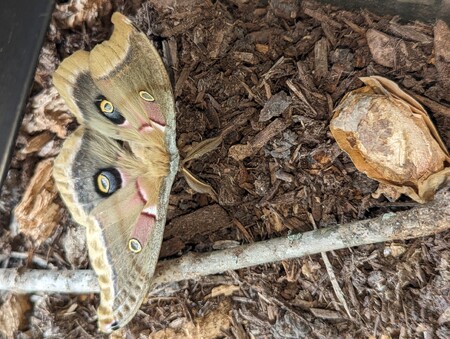
Good Natured: Polyphemus Moth
Last fall we shared the Good Natured news of finding a polyphemus caterpillar at Baker Field Park in St. Charles. (https://www.stcnature.org/good-natured/polyphemus-caterpillar/, if you'd like to check it out.)
That chunky hunk of future moth, about the size of a single Twix bar, quickly created a cocoon of silk and leaves. In turn that oblong pupa, about the size and shape of a rumaki, minus the toothpick (good grief, am I hungry or what?) spent the winter in my garage, ensconced in more leaves inside a canning jar with a screen lid. The cool temperatures there kept little Poly Pupa from developing too quickly while the jar protected it from harm.
Except for one time when I accidentally kicked the jar while carrying in groceries, the ensuing months passed uneventfully—and quickly! I couldn't believe it when my calendar reminded me it was time to bring the cocoon outside, to complete its development.
As luck would have it that date, May 1, was also the day we'd chosen to create a park district video emphasizing the importance of “leaving the leaves"—that is, postponing spring yard cleanup or, even better, allowing leaves and other organic materials to stay in place, thus nourishing the soil and protecting the creatures that live there.
Dan, our video pro, had to coach my colleague Jenny and I to stay on task, but Poly Pupa performed admirably, remaining stock still throughout the one-hour session. Poly's camouflage was on point too, so much so that afterward, when I forgot to pick it up, my coworkers could not find the cocoon amongst the brown leafy substrate.
After a bit of searching the following week, I brought Poly back home and set it up in a 10-gal. aquarium on my deck. Outfitted with a lid, a stick (for the future moth to hang from and spread its wings) and a few inches of soil and decomposing wood chips (as well as six beetle larvae I'd overwintered in the fridge), the tank would provide shelter yet also allow for vital humidity as well as adjustment to seasonal temperatures.
True confession: Early on, I wondered whether we would actually ever see Poly again. When I first removed the cocoon from the jar it seemed really light for its size, and when I gave it a gentle shake, it rattled. Both seemed like signs the pupa had dried up and, like the leaves that surrounded it, would be destined for the compost pile.
But as the days wore on, the cocoon rattled less. And while I never actually weighed it, it felt heavier each time I picked it up. These were good signs!
Then, sometime between the evening of May 11 and the afternoon of May 12, the hoped-for event occurred. Poly eclosed—that is, emerged from its cocoon. Glory be!
Not only was the moth perfect in every way but, looking at its broad, feathery antennae, I saw that it was most definitely a male. He was eager to be set free, so he could use those paired sensory organs to detect the pheromones of any female polyphemus in the area.
As I admired Poly Mothman's form—his exquisite wings, his magnificent antennae—I noticed his plump body was nearly the same size as his cocoon. That chamber had just enough space for him to fully develop, with one catch. The wings could not expand until after he emerged.
By the time I found him that wondrous event had already occurred. The wing veins had filled with hemolymph (a.k.a. insect blood), revealing a stunning pattern of pink, black, blue and yellow against a background of light brown.
I also noticed he'd voided his meconium—the liquid containing the waste products that had built up during his seven months inside his pupal chamber. (And yes, moms in the audience, you are correct. Your human babies' meconia was produced for the same reason, just in larger quantities.)
I must confess though, Poly didn't leave right away. With the weather turning cooler and storms in the forecast, I made the difficult decision to keep him just a couple more days. As the wind blew and the rain fell, Poly bided his time in the aquarium, hanging from the lid and literally chilling until warmer weather returned.
This period of time, it turns out, was just long enough to get my doggone naturalist curiosity kicked into high gear. I removed Poly's cocoon from the tank and pondered its size and shape, its components, its construction. And wham! That's when it hit me. How the heck did he get out of there?
Next week: The mystery is revealed!
Pam Otto is the outreach ambassador for the St. Charles Park District. She can be reached at potto@stcparks.org.

